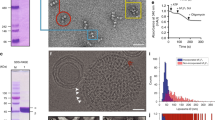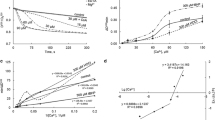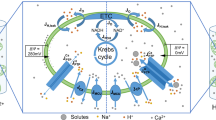Abstract
Mitochondria possess an inner membrane channel, the permeability transition pore, which is inhibited by cyclosporin A (CBA) and by matrix protons. As suggested recently by our laboratory, pore closure by these inhibitors may be due to dissociation of mitochondrial cyclophilin (CyP-M), a matrix peptidyl-prolyl-cis-trans isomerase, from its putative binding site on the pore. Unbinding of CyP-M would follow a CsA-dependent or proton-dependent change in conformation of the CyP-M molecule. It is interesting that upon binding of CsA the enzymatic activity of CyP-M is inhibited, but it is not clear whether this event plays a role in pore inhibition. Here we report experiments designed to further test the role of CyP-M in pore function. Our results indicate that CyP-M-dependent and independent mechanisms of pore activation may exist, and that the peptidylprolyl-cis-trans-isomerase activity of CyP-M is not necessarily involved in pore modulation by CyP-M. (Mol Cell Biochem 174: 181–184, 1997)
Similar content being viewed by others
References
Bernardi P, Broekemeier KM, Pfeiffer DR: Recent progress on regulation of the permeability transition pore, a cyclosporin A-sensitive pore in the mitochondrial inner membrane. J Bioenerg Biomembr 26: 509–517, 1994
Zoratti M, Szabo' I: The mitochondrial permeability transition. Biochim Biophys Acta 1241: 139–176, 1995
Connern CP, Halestrap AP: Recruitment of mitochondrial cyclophilin to the mitochondrial inner membrane under conditions of oxidative stress that enhance the opening of a calcium-sensitive non-specific channel. Biochem J 302: 321–324, 1994
Nicolli A, Basso E, Petronilli V, Wenger RM, Bernardi P: Interactions of cyclophilin with the mitochondrial inner membrane and regulation of the permeability transition pore, a cyclosporin A-sensitive channel. J Biol Chem 271: 2185–2192, 1996
Broekemeier KM, Pfeiffer DR: Inhibition of the mitochondrial permeability transition by cyclosporin A during long time frame experiments: relationship between pore opening and the activity of mitochondrial phospholipases. Biochemistry 34: 16440–16449, 1995
Petronilli V, Cola C, Massari S, Colonna R, Bernardi, P: Physiological effectors modify voltage sensing by the cyclosporin A-sensitive permeability transition pore of mitochondria. J Biol Chem 268: 21939–21945, 1993
Fischer G, Bang H, Berger E, Schellenberger A: Conformation specificity of chymotrypsin toward proline-containing substrates. Biochim Biophys Acta 791: 87–97, 1984
Harrison RK, Stein RL: Substrate Specificity of the peptidyl prolyl cis-trans isomerase activities of cyclophilin and FK-506 binding protein: evidence for the existence of a family of distinct enzymes. Biochemistry 29: 3813–3816, 1990
Petronilli V, Costantini P, Scorrano L, Colonna R, Passamonti S, Bernardi P: The voltage sensor of the mitochondrial permeability transition pore is tuned by the oxidation-reduction state of vicinal thiols. Increase of the gating potential by oxidants and its reversal by reducing agents. J Biol Chem 269: 16638–16642, 1994
Bernardi P: Modulation of the mitochondrial cyclosporin A-sensitive permeability transition pore by the proton electrochemical gradient. Evidence that the pore can be opened by membrane depolarization. J Biol Chem 267: 8834–8839, 1992
Nicolli A, Petronilli V, Bernardi P: Modulation of the mitochondrial cyclosporin A-sensitive permeability transition pore by matrix pH. Evidence that the pore open-closed probability is regulated by reversible histidine protonation. Biochemistry 32: 4461–4465, 1993
Author information
Authors and Affiliations
Rights and permissions
About this article
Cite this article
Scorrano, L., Nicolli, A., Basso, E. et al. Two modes of activation of the permeability transition pore: The role of mitochondrial cyclophilin. Mol Cell Biochem 174, 181–184 (1997). https://doi.org/10.1023/A:1006887921810
Issue Date:
DOI: https://doi.org/10.1023/A:1006887921810




